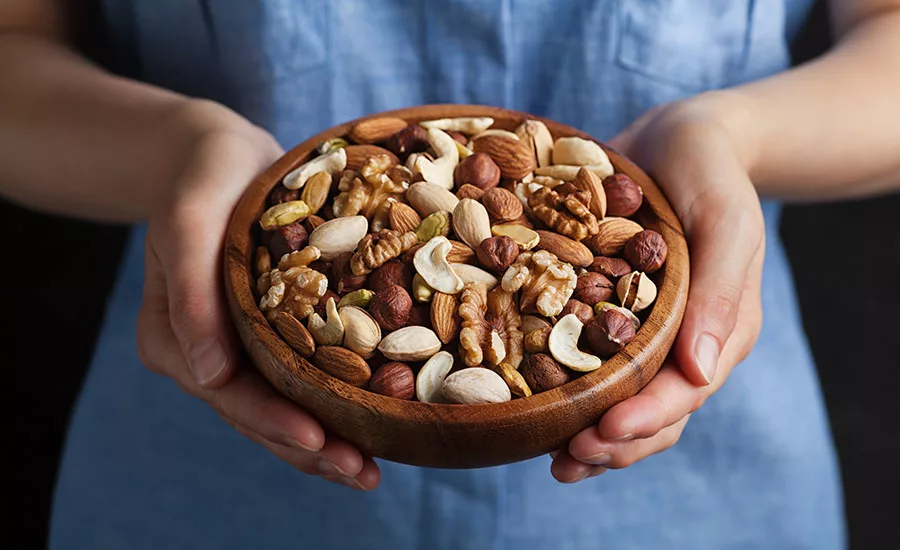Pasteurization
The importance of maintaining nutritional and sensory quality in pasteurized food
While thermal pasteurization can affect quality in nuts and seeds, finding the right non-thermal process can render product with no noticeable product changes

Today’s consumers are savvier than ever about what they eat and why they eat it. In the 1980s and 1990s, low-carbohydrate and low-fat foods were seen as the key to a healthy diet. Now, knowledgeable consumers seek a balanced healthy diet that is nutrient-dense and plant-based, incorporating the increasingly popular staples of nuts, whole grains and seeds.
Data indicate that the global nuts and seeds market will grow to more than $1.3 billion by 2024.[1] Combine this with the rise of plant-based diets, and consumers continue to choose easy, readily-available and nutritious ingredients to include in their daily meals. When choosing foods, nutritional value along with sensory factors, such as appearance, taste, smell and texture, can play a critical role in a consumer’s food preferences and eating habits. Many consumers eat with two crucial elements in mind: nutrition value and sensory quality.
However, the natural, key nutrients and sensory qualities of nuts, whole grains and seeds are not always maintained from farm to table. These foods are often pasteurized to keep food safe, eliminate pathogens, such as Salmonella and E. coli, and extend shelf life.
“Some pasteurization methods, such as steam, use high levels of heat to kill the pathogens,” explains Rob Wong, president at Agri-Neo. “However, this method may ‘cook’ the food to some extent and may degrade its sensory and nutritional qualities depending on the duration of the heat exposure. Other pasteurization processes use propylene oxide (PPO) to reduce bacteria, yeasts and mold on raw food. PPO has been classified as a potential carcinogen and may not be healthy for consumption.” [2]
Agri-Neo was featured in FE’s Engineering R&D column in November 2016. You can read about the process in more detail by visiting “A new approach to pathogen-free seeds and grains.”
“Food processors seek pasteurization methods that preserve the key nutrients in nuts, seeds and whole grains while ensuring the food is safe, and Neo-Pure provides the solution,” says Wong. “The organic, non-thermal pasteurization method keeps nuts, seeds and whole grains safe to eat without compromising vital nutrients and fundamental sensory qualities people want.”
Nuts, whole grains and seeds deliver sensory and nutritional value
Nuts, whole grains and seeds are staples for nutrient-dense diets. They provide vital nutrients for our bodies and can be especially important to people who eat a plant-based diet. Vegans, for example, can struggle to get enough protein, calcium and iron in their diet for optimal nutrition. Including a combination of nuts, whole grains and seeds in a vegan diet can help deliver these nutrients with delicious mouthfeel and crunch. To boost the body’s absorption of plant-based iron sources in salads and other vegan dishes, consumers can pair nuts, whole grains and seeds with vitamin C sources, such as fruits and vegetables high in vitamin C.
Looking for quick answers on food safety topics?
Try Ask FSM, our new smart AI search tool.
Ask FSM →
Nuts supply important nutrients such as plant-based healthy fats, essential fatty acids and iron. A one-ounce serving of almonds provides six grams of protein, 3.5 grams of dietary fiber, 75 milligrams of calcium and 1.1 milligrams of iron. Just two tablespoons of chia seeds are a rich source of plant-based omega-3 fatty acids and fiber, in addition to providing protein, calcium, magnesium and zinc.
A person’s sensory perceptions of food can play a vital role in food preferences and healthy eating habits. Four sensory elements (sight, smell, taste and touch) determine sensory responses to the appearance, aroma, taste and mouthfeel of foods and also can contribute to a person’s food purchasing patterns.
Consumers may make a first-time food purchase based on appearance alone, while repeat purchasers often make decisions based on expected sensory qualities of foods from eating pleasure and experience. How pleasurable and how consistent eating experiences of food are can determine repeat purchase probability. For example, many people enjoy eating nuts for the crunchiness and deep flavor they provide.
However, if the sensory qualities, such as “nutty, fresh, sweet, crunchy,” are lacking, the consumer’s expectations are not met, and the consumer is less likely to repeat the purchase due to the inconsistency of the product.
“Steam pasteurization that exposes food to high heat for too long can cause the skin to pull away and shrivel, changing the mouthfeel and texture of the food. Steam can also alter the natural taste of the treated food, creating a bland, flavorless product,” says Dr. Amir Hamidi, food safety science leader at Agri-Neo.
Non-thermal pasteurization and maintaining sensory elements and raw nutrients of food
Consumers crave foods that satisfy the sensory qualities they enjoy and nutrient-dense foods. As the demand for nuts, seeds and whole grains rise, food processors look to process more volume, ensure food is safe to eat and maintain its essential nutrients and sensory characteristics.
“Organic, non-thermal pasteurization, such as Neo-Pure from Agri-Neo, maintains the product integrity of nuts, whole grains and seeds, providing consumers with essential raw ingredients,” says Dr. Hamidi. “Neo-Pure provides a validated 5-log kill step for a wide range of low-moisture foods while maintaining the nutritional and sensory qualities of nuts, grains and seeds.”
Research published in the Journal of Food Protection demonstrated the efficacy of the Neo-Pure non-thermal pasteurization method on pathogen reduction in chia and flax seeds. Using Neo-Pure, the treated seeds maintained germination ability (i.e., sprouting) and key nutrients, and preliminary sensory studies showed no effect on sensory qualities.[3] Researchers compared the nutritional value of raw seeds to Neo-Pure treated seeds. Both of the seed variations maintained natural levels of the nutritional characteristics that consumers desire with no significant changes from the raw state. Preliminary sensory studies also showed no effect on sensory characteristics. The non-thermal pasteurization process did not significantly impact the natural ability of seeds to germinate with no significant change from the raw state.
The process eliminates pathogens such as Salmonella, E. coli and Listeria by combining Neo-Pure, an organic liquid solution, with a system designed specifically for food processing. As explained by Dr. Hamidi, Neo-Pure completely biodegrades after eliminating pathogens, which allowed it to receive approval from the U.S. Food and Drug Administration, U.S. Environmental Protection Agency and Health Canada as a processing aid.
Nutrition is continually advancing. Updated nutrition research provides new insights and nutrition guidelines change. Old nutrition guidelines used to recommend a low-fat diet, but now, healthy fats are recognized as an important part of an overall balanced eating plan for long-term health. Plant-based nuts, whole grains and seeds provide these healthy fats, with other key nutrients and pleasing sensory qualities that can make seemingly boring meals not only nutritious but also exciting and delicious. As summarized by Wong, “Using the Neo-Pure non-thermal pasteurization system, food processors can provide consumers with the raw taste and nutrition found naturally in nuts, whole grains and seeds.”







.webp?t=1721343192)
